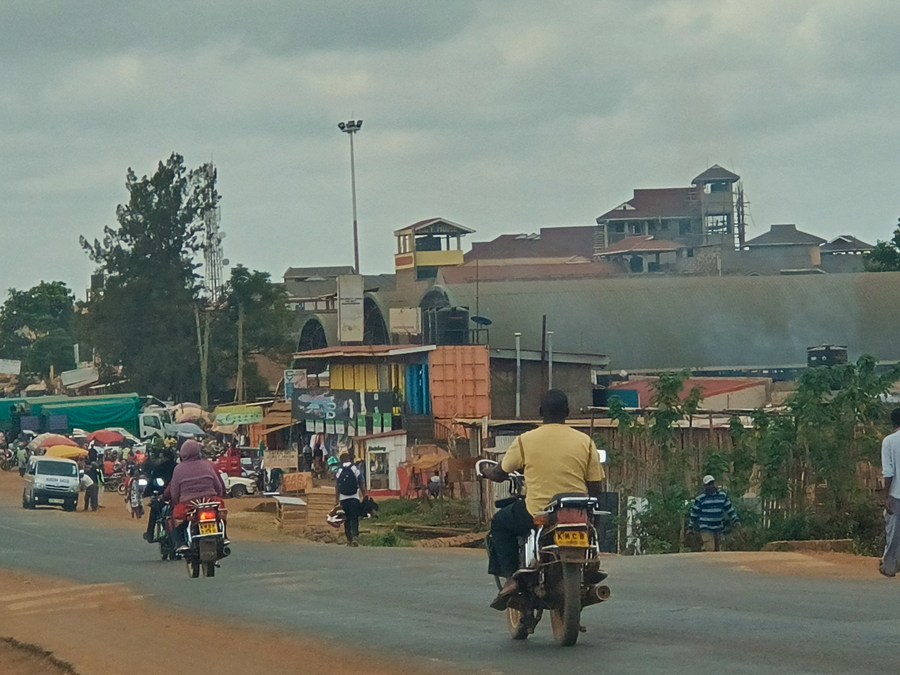
Motorcycle taxi riders go about their work at Kagio Market in Kirinyaga County, Kenya, on Sept. 19, 2023. (Photo by David Musyoka/Xinhua)
Riders of Kenya's commercial motorcycles, popularly known in Kiswahili as boda boda, are planning to switch to electric motorcycles in their next purchases, given the rising fuel prices and the growing calls for a transition to a green economy.
NAIROBI, Sept. 29 (Xinhua) -- Riders of Kenya's commercial motorcycles, popularly known in Kiswahili as boda boda, are planning to switch to electric motorcycles in their next purchases, given the rising fuel prices and the growing calls for a transition to a green economy.
John Kamwangi, a commercial rider in Kutus town, located in the heart of the central Kenyan county of Kirinyaga, said that he makes a daily net profit of 500 shillings (about 3.4 U.S. dollars) on average. Kamwangi currently spends nearly the same amount from his daily earnings on purchasing petrol or gasoline to fuel his motorcycle.
"We have been informed that electric motorcycles will only consume a charge worth approximately 1.35 dollars per day. This means I could nearly double my daily profits. That's why my next purchase will be an electric motorcycle. The challenge we are facing is how to dispose of our existing petrol-powered motorcycles because many people are now interested in electric motorcycles," he said.
According to the Kenya Economic Survey 2023, Kenya registered 321,200 new motorcycles in 2022. Overall, the National Transport and Safety Authority estimates that there are at least a total of 1.3 million motorcycles in the country, with the majority being used for commercial passenger transport.
Out of these numbers, only a negligible amount are electric motorcycles. This year, mass awareness about electric motorcycles has grown following a pledge by President William Ruto to facilitate the widespread adoption of electric motorcycles in the country.
"Between now (September 2023) and December 2024, we plan to have at least 200,000 electric motorcycles on our roads," Ruto said during the Africa Climate Summit held in the Kenyan capital of Nairobi early this month.
Both the president and ordinary Kenyans are eager to capitalize on the opportunities offered by electric motorcycles, driven in part by the rising and unpredictable cost of fuel, which eats into their earnings.
The government views the switch to electric motorcycles as a way to mitigate the high cost of living for citizens because, with electric bikes, the cost of powering them is low, leading to increased profits for riders and lower transport charges for passengers. Additionally, Kenya aims to position itself as a leader in green energy, with electric motorcycles presenting an opportunity to reduce the consumption of fossil fuels, thus curbing carbon emissions and saving on the dollars spent on oil imports.
Furthermore, Kenya, East Africa's largest economy, seeks to boost the demand for its electricity, the majority of which is generated from hydro, geothermal, and wind sources, according to state-owned power utilities. In August 2023, the country's peak electricity demand reached 2,170 megawatts, according to John Mativo, the managing director and chief executive officer of the Kenya Electricity Transmission Company.
The installed electricity capacity in Kenya reached 3,074 megawatts in June, compared to 2,972 megawatts a year earlier, as reported by the Energy and Petroleum Regulatory Authority.
Joseph Wambui, who works as a commercial motorbike rider in Embu town, about 125 km northeast of Nairobi, has postponed his plans to purchase a petrol-powered motorbike using his savings and expected annual tea bonus payments, which are set to be deposited into his bank account in early October.
"I had planned to buy my motorcycle for commercial passenger business by mid-October. However, I will wait. I have changed my mind. Instead, I will buy an electric motorcycle. We have been informed that people selling them will come to educate us on how to use, maintain, and charge them. That's what I'm now waiting for," Wambui said.

Motorcycle taxi riders wait for customers at Kagio Market in Kirinyaga County, Kenya, on Sept. 19, 2023. (Photo by David Musyoka/Xinhua)
At the passenger pickup point for motorcycles in Embu town, at least half of the 18 riders told the reporter that they prefer electric motorcycles. They said that if the government facilitates the exchange of petrol-powered bikes for electric ones, they are ready to contribute extra funds to acquire them.
"The cost of operating these petrol-powered bikes is quite high. We do not want to keep increasing the cost of transportation because that could result in losing customers. Electric bikes are the solution, and we want them as soon as possible," remarked Karimi Njue, a young rider.
It may only be a matter of time before these riders and others across the country start using electric motorcycles, following a presidential directive that offers tax incentives to manufacturers of electric bikes by removing the 16 percent value-added tax, which could make them even more affordable to purchase.
Similar incentives have also been extended to manufacturers of batteries used to power these bikes. The tax incentive is already yielding results.
On Sept. 21, ARC Ride, an e-mobility startup, announced that it will begin assembling electric motorcycles in Nairobi. The company was previously importing such motorcycles. Additionally, it planned to expand its battery swap stations across the capital city and the neighboring Kiambu County by 300. Another company, known as Nairobi Business Venture, has also revealed the initiation of local assembly for electric motorcycles, as stated by Haresh V D Soni, the firm's chief executive officer.
While charging stations have been predominantly concentrated in urban areas, the government has now formulated plans to ensure equitable service in rural areas as well.
The Energy and Petroleum Regulatory Authority, the energy industry regulator, has issued new regulatory guidelines that stipulate public charging stations for electric motorcycles and vehicles should be located every 25 km along major highways.
These guidelines require at least one charging station within a grid measuring three km by three km, one charging station every 25 km on both sides of highways or roads, and at least one fast-charging station with appropriate charging infrastructure every 100 km, one on each side of highways or roads. ■












